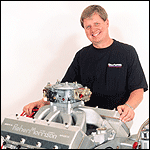 By David Reher, Reher-Morrison Racing Engines
By David Reher, Reher-Morrison Racing Engines
“The most important electrical tool a racer can own is an ohmmeter.”
The combustion triangle we learned in science class defines an engine’s three essential needs: fuel, air and spark. If any of these three items are inadequate, the engine can’t achieve its maximum performance potential. I’ve written columns about fuel systems and airflow, but I’ve not previously addressed the importance of a reliable ignition system in drag racing. This month I’ll try to fill in that missing leg of the combustion triangle.
Drag racing ignition systems have progressed tremendously from the days of dual-point distributors. In practice, a cam-driven distributor is a rather inaccurate timing device for a racing engine. The camshaft drive system, camshaft torsional twist, and lash between the cam and distributor gears create spark scatter that can vary ignition timing by several degrees. If you’re watching your racing budget and simply want to get the biggest bang for your buck, then a quality aftermarket distributor can be a good value – but if your goal is to make the most power possible, then I wouldn’t recommend a distributor ignition system.
The next step in ignition precision is a crankshaft-triggered system, which eliminates the inaccuracies inherent in a distributor-triggered ignition. With a crank trigger, the distributor becomes a simple rotary switch that directs the spark to the appropriate cylinder.
A crank trigger ignition system has virtues that any racer appreciates: simplicity, accuracy and reliability. This doesn’t mean, however, that a crank trigger ignition is foolproof. The transducer that senses the rotating magnets must be treated kindly. The threads are large and require a big wrench, but the transducer case is thin and can be easily damaged by overtightening the fasteners. Please, put away the breaker bar and just snug the nuts.
Most crank triggers for V-8 engines employ four equally spaced magnets mounted in the trigger wheel. These magnets have been known to come out, and when that happens, two cylinders go dead. If an engine suddenly develops a severe misfire, make sure that all of the magnets are where they belong.
In this age of “black box” systems, diagnosing ignition problems at the track can be difficult. The most important electrical tool a racer can own is a simple ohmmeter. I use my ohmmeter frequently to check the continuity of circuits and to measure resistance in spark plug wires.
When an engine has an ignition-related misfire, it’s tempting to change ignition boxes, transducers and coils. But don’t overlook the simple solution: Are the spark plugs and wires OK? I’ve felt foolish more than once after changing an entire ignition system only to discover that the problem was a bad plug.
To test a spark plug, I put the ohmmeter probes on the center electrode and the wire terminal. If there is high internal resistance, there’s a good chance that plug is going to foul. You might check dozens of plugs and never find a bad one, but occasionally a defect turns up. When I check every plug before installing a new set, I don’t have to worry about losing an important run because of a dead spark plug.
It’s a good idea to replace spark plug wires periodically. Spark plug wires that suppress electro-magnetic interference are a necessity in our electronics-rich race cars, but these wires can degrade over time. Checking the resistance of suppression wires on the workbench doesn’t guarantee that they’ll work properly in the race car when they’re curved around header pipes and chassis tubes.
The spark plugs must be grounded to complete the electrical circuit. That may seem obvious, but if the cylinder heads aren’t grounded properly, the electrical charge will find an alternative path of less resistance. A ground strap bolted to the engine block may not do the job; head gaskets, silicon and bolt sealer can electrically insulate the cylinder heads from ground. An effective, easy solution is to connect the heads with a wire, and then to run the wire to a clean, grounded connection on the frame. This wire doesn’t have to be as thick as a welding cable, but just big enough to provide a low-resistance path for the electrons.
The digital revolution has put sophisticated electronic ignition controls within the reach of virtually every serious drag racer. However, as with many technological advances, there is a tendency to buy more computing power than is really necessary. Why pay for a supercomputer when all you need is a pocket calculator?
Pro Stock racers don’t have a choice in ignition systems. The NHRA Rule Book mandates the MSD Digital-7 programmable ignition in Pro Stock to prevent the use of illegal traction control devices. This specified spark box has impressive capabilities, including the ability to program individual cylinder ignition timing, set timing curves in every gear, and ramp retard stages. But for a typical weekend racer, a programmable ignition offers way too many choices.
Complexity brings opportunities for errors. If you’re not diligent about reviewing and updating the programming data, you can find yourself in ignition hell if a setting isn’t correct. If your normal prerace routine is to check the timing with a strobe light, the only cylinder you’re checking with a programmable ignition is the one that’s attached to the light. Simply moving the transducer to adjust ignition timing while the engine is running can be interpreted as a form of traction control, causing the programmable ignition box to go into default mode and restrict engine speed to 4000 rpm.
If you’re not going to use all of the bells and whistles, my advice is to keep it simple with a good quality, midrange ignition system. Time and money spent maintaining the battery, wires, and cables in top-notch condition will add spark to your race car.
